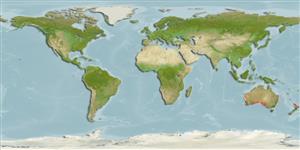Issue
Platycephalus grandispinis was found to have priority over P. longispinis by Imamura, 2013 (Ref. 94990).
Environment: milieu / climate zone / depth range / distribution range
Ecology
Marine; demersal; depth range 10 - 75 m (Ref. 9563). Subtropical; 24°S - 39°S
Eastern Indian Ocean: endemic to Australia.
Length at first maturity / Size / Weight / Age
Maturity: Lm 17.5 range ? - ? cm
Max length : 38.0 cm TL male/unsexed; (Ref. 9563)
Dorsal spines (total): 8; Dorsal soft rays (total): 14; Anal soft rays: 14. This species is distinguished by the following characters: D2 14; A 14; lateral line scales 73-82; total gill rakers 19-26; interorbit becoming wider with growth, narrower than orbital diameter; no distinct interopercular flap, sometimes a small flap or weak convexity is present; supraoccipital with a ridge; much longer preopercular spine than upper, often extending nearly to posterior margin of opercle, length ratio of lower to upper spines, 1.9-3.3:1 and this ratio tends to become smaller with growth; no large canine teeth on anteromedial part of upper jaw; no small dark dots on head and body; posteroventral part of caudal fin with blackish or dark-brownish marking (Ref. 94990).
Found inshore (Ref. 7300).
Life cycle and mating behavior
Maturity | Reproduction | Spawning | Eggs | Fecundity | Larvae
Imamura, H., 2013. Validity of Platycephalus grandispinis Cuvier, 1829, with priority over Platycephalus longispinis Macleay, 1884 (Actinopterygii: Scorpaeniformes: Platycephalidae). Species Diversity 18:183-192. (Ref. 94990)
IUCN Red List Status (Ref. 130435: Version 2024-2)
Threat to humans
Harmless
Human uses
Tools
Special reports
Download XML
Internet sources
Estimates based on models
Preferred temperature (Ref.
123201): 15.3 - 23.3, mean 17.9 °C (based on 200 cells).
Phylogenetic diversity index (Ref.
82804): PD
50 = 0.5000 [Uniqueness, from 0.5 = low to 2.0 = high].
Bayesian length-weight: a=0.00457 (0.00230 - 0.00908), b=3.09 (2.91 - 3.27), in cm total length, based on LWR estimates for this (Sub)family-body shape (Ref.
93245).
Trophic level (Ref.
69278): 3.8 ±0.4 se; based on diet studies.
Resilience (Ref.
120179): Medium, minimum population doubling time 1.4 - 4.4 years (Preliminary K or Fecundity.).
Fishing Vulnerability (Ref.
59153): Moderate vulnerability (35 of 100).
